Battery Energy Storage System Market Size
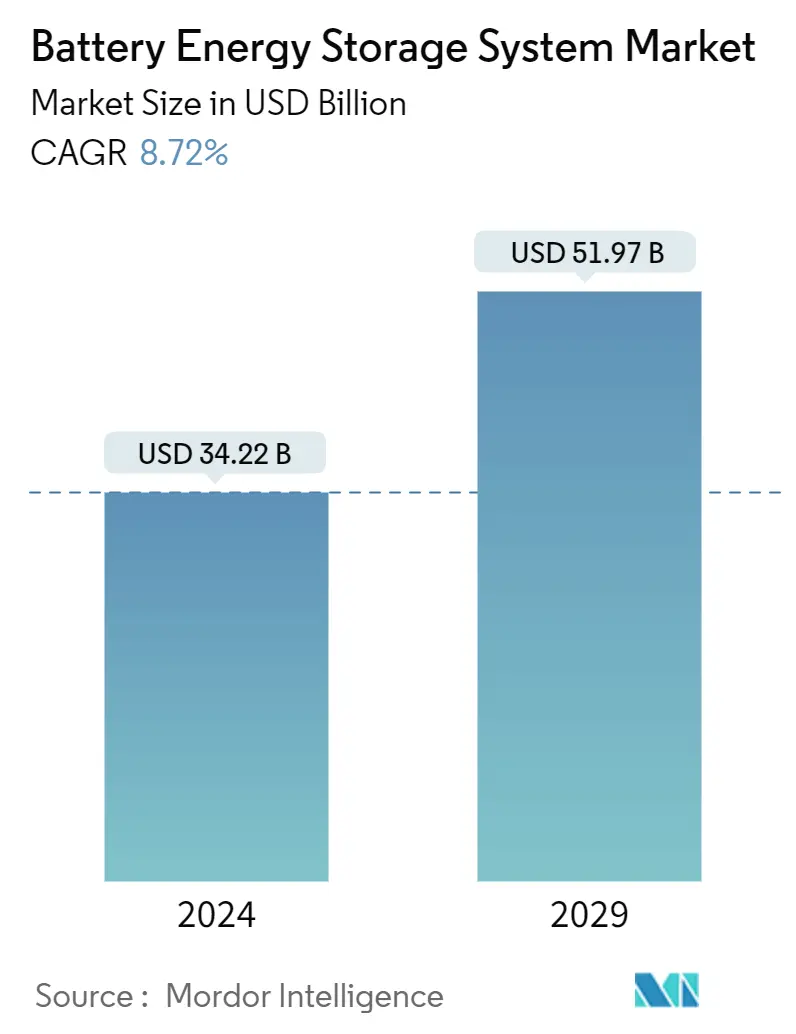
| Study Period | 2019 - 2029 |
| Market Size (2024) | USD 34.22 Billion |
| Market Size (2029) | USD 51.97 Billion |
| CAGR (2024 - 2029) | 8.72 % |
| Fastest Growing Market | Asia Pacific |
| Largest Market | Asia Pacific |
Major Players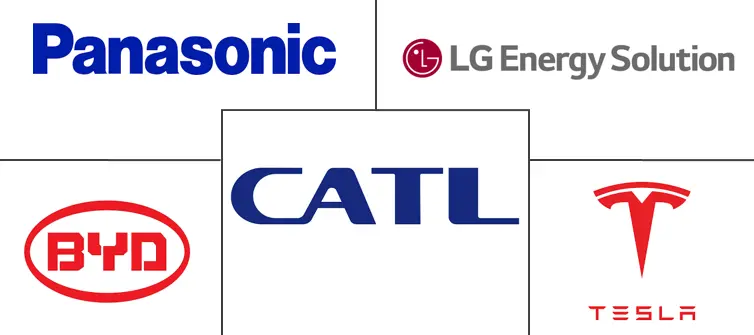
*Disclaimer: Major Players sorted in no particular order |
Battery Energy Storage System Market Analysis
The Battery Energy Storage System Market size is estimated at USD 34.22 billion in 2024, and is expected to reach USD 51.97 billion by 2029, growing at a CAGR of 8.72% during the forecast period (2024-2029).
- Over the medium term, factors such as declining prices of lithium-ion batteries and increased penetration of renewable energy are likely to drive the battery energy storage systems market in the forecast period.
- On the other hand, the demand-supply mismatch of raw materials like cobalt, lithium, copper, etc., will likely hinder the growth of the battery energy storage systems (BESS) market in the studied period.
- Nevertheless, technological advancements in new battery technologies to store energy will likely create lucrative growth opportunities for the BESS market during the forecast period.
- Asia-Pacific is the fastest-growing market during the forecast period due to the rising energy demand. This growth is attributed to increasing investments, coupled with supportive government policies in the countries of this region, including India, China, and Australia.
Battery Energy Storage System Market Trends
Residential Expected to be the Fastest-growing Segment
- Residential energy storage systems are small-scale rechargeable batteries paired with distributed generation sources, mainly rooftop solar photovoltaic (PV) systems. Most residential battery energy storage systems (BESS) have a capacity of 2.5-25.2 kWh and a nominal voltage of nearly 50 V. However, systems with higher nominal voltage outputs are available in the market. Most of these Li-ion BESS are of Lithium Nickel Manganese Cobalt Oxide (NMC) or Lithium Iron Phosphate (LiFePO4) battery chemistry.
- In recent years, the energy storage system (ESS) has experienced significant growth, especially in the residential sector, along with rising investments in renewable energy infrastructure across the country. Electricity consumption in the residential sector is estimated to increase during the forecast period due to increasing annual disposable incomes, rising work-from-home trends, and rising power consumption across the globe. Energy storage systems are used for continuous power supply at homes during power outages at peak hours.
- According to SolarPower Europe, the European region installed residential battery energy storage of about 2.3 GWh in 2021, a two-fold increase from the previous year. The rise in installations was attributed to the mandatory installation of solar energy systems on new and renovated buildings as directed by the European Commission and battery storage targets as part of the National Clean Flexibility Plan as per ’ National Energy and Climate Plans (NECPs). This is likely to escalate the same in the future as well.
- Many European countries have charted energy storage installation targets. For instance, according to the Spanish Energy Storage Association, the nation aims to achieve 20 GW of energy storage installations by 2030 and 30 GW by 2050 as part of its new strategy.
- The cost of battery energy storage systems declined due to favorable government incentives and tax cuts. For instance, in March 2022, the UK government introduced new legislation, reversing the legislative changes brought in by the Court of Justice of the European Union, through which the government mandated a zero VAT rate for energy-saving technologies for residential accommodations, including residential BESS units. This tax cut would be valid for five years, after which the VAT rate will likely be revised to 5%.
- In renewable power sources, the majority of residential demand comes from the solar energy segment, which, in turn, creates demand for residential battery energy storage systems. For instance, according to France Territoire Solaire, in Q4 2023, France's total residential photovoltaic solar energy capacity accounted for 2,645 MW, an increase of 36.4 % compared to Q4 2022.
- In June 2022, Toyota entered the energy storage market by launching the O-Uchi Kyuden System, a residential battery product. Toyota launched a rated output of 5.5 kWh and a rated capacity of 8.7 kWh battery storage system. It uses the company's electric vehicle battery technology. When connected to a photovoltaic rooftop system, the system can power a home day and night. Initially, the company aimed to sell the storage system in Japan.
- Therefore, owing to these factors, the residential application is expected to create lucrative demand in the battery energy storage systems market during the forecast period.
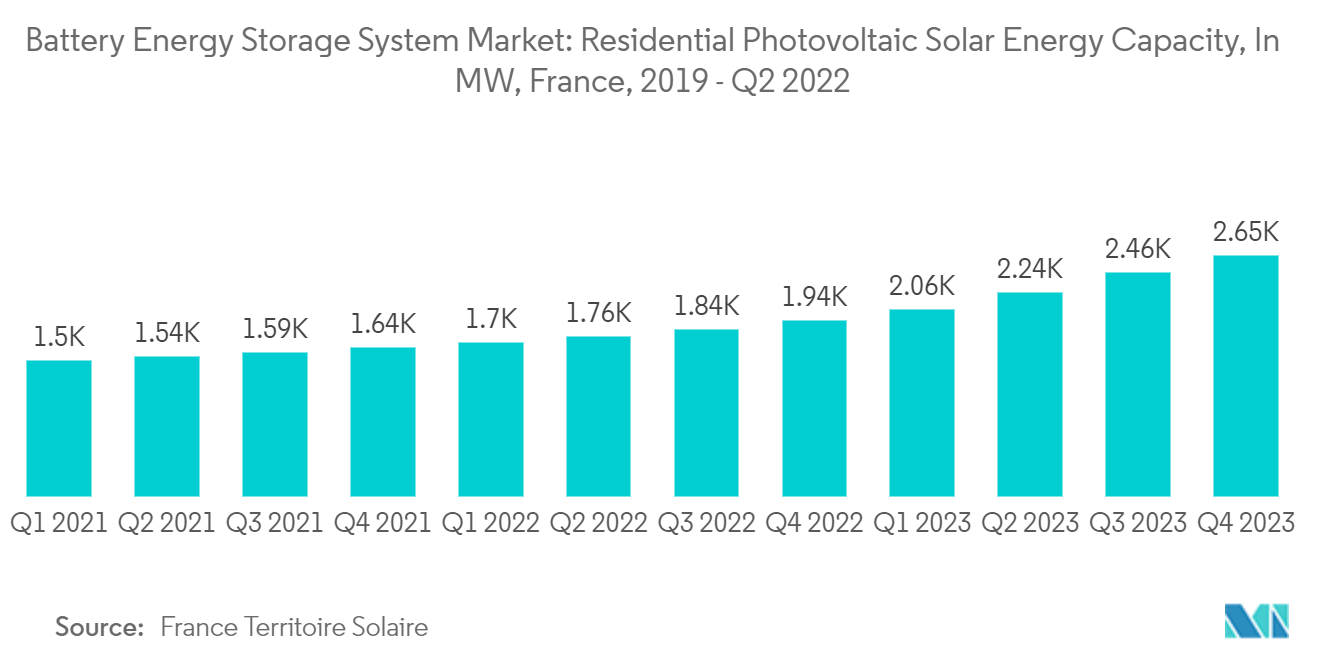
Asia-Pacific Expected to Witness Faster Growth
- Asia-Pacific is expected to keep leading the market for battery energy storage over the next few years. The region consists of two main types of power grids, each with different characteristics and opportunities for energy storage systems. On one side are highly developed countries like Japan, South Korea, New Zealand, and Australia, as well as other large cities with advanced grids that work well and use the latest technologies.
- In the first half of 2023, China's new energy storage continued to develop at a high speed, with 850 projects (including planning, under construction, and commissioned projects), over twice that of the same period in 2022. The newly commissioned scale is 8.0GW/16.7 GWh, higher than the new scale level last year (7.3GW/15.9GWh) in 2022. The newly added projects were mainly put into operation in June, and the capacity reached 3.95GW/8.31GWh, accounting for 50% of the total increased capacity of operating projects in the first half of 2023. Further, it is expected that it will likely continue to maintain significant growth in the coming years.
- Similarly, in India, According to the government, the energy storage requirement is expected to soar to 73.93 GW (26.69 GW PSP and 47.24 GW BESS) with a significant storage capacity of 411.4 GWh by 2031-32. To develop the energy storage capacity from 2022 to 2032, an estimated fund requirement of over INR 54,203 crore for PSP and USD 6.7 billion for BESS is anticipated.
- Further, CEA has also set its sights on the long-term, projecting that by 2047, the country's energy storage demand will likely reach about 320 GW (90 GW PSP and 230 GW BESS) with a total energy storage capacity of 2,380 GWh, aligning with the country's aim to achieve the net zero emissions by 2070 and the rapid renewable energy growth.
- According to the Statistical Review of World Energy Data, in the Asia Pacific region, electricity generation will increase by 4% in 2022 as compared to 2021, the majority due to renewable sources of energy. Furthermore, the Japanese government has set a goal of reaching carbon neutrality by 2050. It intends to boost production from renewables in the overall energy generation to 36-38% by 2030, with solar and wind accounting for 19-21%. The country's prior objective was for renewables to increase from 18% to 22-24% in 2019-2020.
- China is investing heavily in battery energy storage systems (BESS), targeting 100 GW energy storage capacity by 2030. The 14th FYP set the tone to support all types of BESS, including novel lithium-ion, sodium-ion, lead-carbon, and redox flow. The battery energy storages have the advantages of high capacity, low cost, long life cycles, and fast response times. The goal is to boost the build-out of independently owned battery energy storage facilities to support and balance the rapidly growing but intermittent generation capacity from wind turbines and solar panels in the coming years.
- Furthermore, in September 2023, the Union Cabinet of India approved the viability gap funding scheme (VGF) to create a robust storage system for excess wind and solar power production. A total of 4,000 megawatt hours (MWh) of Battery Energy Storage System (BESS) projects will be developed by FY31 under the scheme. An initial outlay of USD 1,128.18 million, including budgetary support of USD 451.27 million, has been provided under the scheme.
- Therefore, owing to such factors, Asia-Pacific is expected to dominate the market during the forecast period.
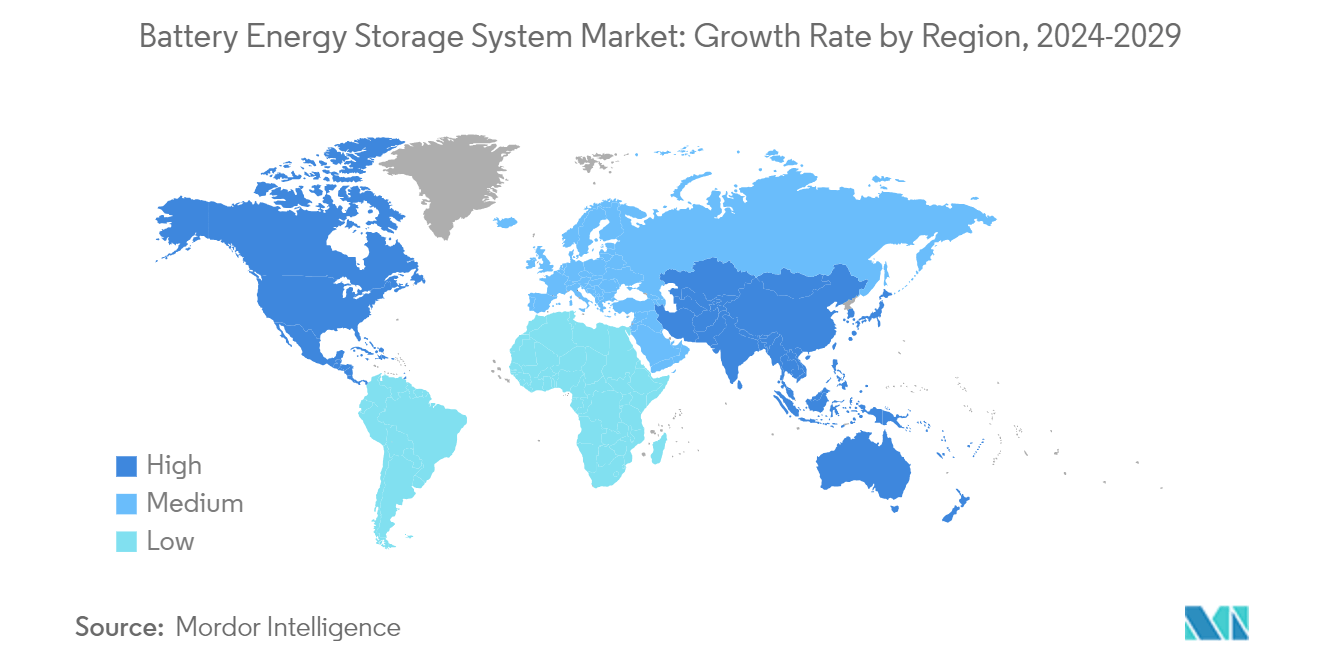
Battery Energy Storage System Industry Overview
The battery energy storage system market is fragmented. Some of the major players in the market (in no particular order) are BYD Company Limited, Panasonic Corporation, LG Energy Solution Ltd., Tesla Inc., and Contemporary Amperex Technology Co. Limited.
Battery Energy Storage System Market Leaders
-
BYD Company Limited
-
Contemporary Amperex Technology Co. Limited
-
Tesla Inc
-
Panasonic Corporation
-
LG Energy Solution, Ltd.
*Disclaimer: Major Players sorted in no particular order
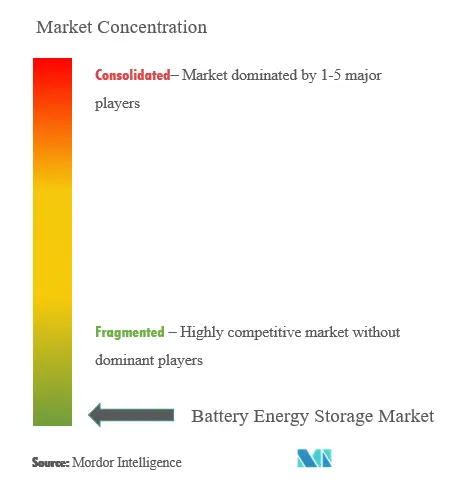
Battery Energy Storage System Market News
- February 2024: Chhattisgarh successfully inaugurated one of the biggest solar facilities in India with a battery energy storage system located in the Rajnandgaon district. The solar power plant, established by the Solar Corporation of India (SECI) and Chhattisgarh Power Distribution Company, provides a capacity of 100 MW, ensures electricity even during the night, and generates more than five lakh units daily.
- February 2024: GFCL EV Products Ltd. (GFCL EV), a subsidiary of Gujarat Fluorochemicals Ltd (GFL), plans to invest INR 6000 crore (USD 720 million) to supply 200GWh EV and battery energy storage system (BESS) solutions globally in the next 4-5 years. GFL has already committed INR 650 crore (USD 78 million) of the entire investment till December 31, 2023, with GFCL EV set to join EV and ESS battery markets in the United States, Europe, and India.
- December 2023: Namibia Power Corporation (NamPower) inked significant EPC contracts with Shandong Electrical, Engineering, and Equipment Group (SDEE) and Narada Power for a grid-scale battery energy storage project. The joint venture between the two Chinese enterprises is expected to deliver the 54MW/54MWh battery energy storage system (BESS) to Namibia's Omburu substation in the Erongo region.
Battery Energy Storage System Market Report - Table of Contents
1. INTRODUCTION
- 1.1 Scope of the Study
- 1.2 Market Definition
- 1.3 Study Assumptions
2. RESEARCH METHODOLOGY
3. EXECUTIVE SUMMARY
4. MARKET OVERVIEW
- 4.1 Introduction
- 4.2 Market Size and Demand Forecast in USD, until 2029
- 4.3 Recent Trends and Developments
- 4.4 Government Policies and Regulations
-
4.5 Market Dynamics
- 4.5.1 Drivers
- 4.5.1.1 Increased Demand of Renewable Energy
- 4.5.1.2 Reducing Prices of Lithium-ion Batteries
- 4.5.2 Restraints
- 4.5.2.1 Reduction in Supply of Raw Materials
- 4.6 Supply Chain Analysis
-
4.7 Porter's Five Forces Analysis
- 4.7.1 Bargaining Power of Suppliers
- 4.7.2 Bargaining Power of Consumers
- 4.7.3 Threat of New Entrants
- 4.7.4 Threat of Substitutes Products and Services
- 4.7.5 Intensity of Competitive Rivalry
5. MARKET SEGMENTATION
-
5.1 Type
- 5.1.1 Lithium-ion Batteries
- 5.1.2 Lead-acid Batteries
- 5.1.3 Nickel Metal Hydride
- 5.1.4 Other Types (Sodium-sulfur Batteries and Flow Batteries)
-
5.2 Application
- 5.2.1 Utility
- 5.2.2 Commercial and Industrial
- 5.2.3 Residential
-
5.3 Geography
- 5.3.1 North America
- 5.3.1.1 United States
- 5.3.1.2 Canada
- 5.3.1.3 Rest of North America
- 5.3.2 Europe
- 5.3.2.1 Germany
- 5.3.2.2 France
- 5.3.2.3 United Kingdom
- 5.3.2.4 Italy
- 5.3.2.5 Spain
- 5.3.2.6 Nordic
- 5.3.2.7 Turkey
- 5.3.2.8 Russia
- 5.3.2.9 Rest of Europe
- 5.3.3 Asia-Pacific
- 5.3.3.1 China
- 5.3.3.2 India
- 5.3.3.3 Japan
- 5.3.3.4 Australia
- 5.3.3.5 Malaysia
- 5.3.3.6 Thailand
- 5.3.3.7 Indonesia
- 5.3.3.8 Vietnam
- 5.3.3.9 Rest of Asia-pacific
- 5.3.4 South America
- 5.3.4.1 Brazil
- 5.3.4.2 Argentina
- 5.3.4.3 Chile
- 5.3.4.4 Colombia
- 5.3.4.5 Rest of South America
- 5.3.5 Middle East and Africa
- 5.3.5.1 Saudi Arabia
- 5.3.5.2 United Arab Emirates
- 5.3.5.3 South Africa
- 5.3.5.4 Qatar
- 5.3.5.5 Nigeria
- 5.3.5.6 Egypt
- 5.3.5.7 Rest of Middle East & Africa
6. COMPETITIVE LANDSCAPE
- 6.1 Mergers and Acquisitions, Joint Ventures, Collaborations, and Agreements
- 6.2 Strategies Adopted by Leading Players
-
6.3 Company Profiles
- 6.3.1 BYD Company Limited
- 6.3.2 Panasonic Corporation
- 6.3.3 LG Energy Solution Ltd.
- 6.3.4 Contemporary Amperex Technology Co. Limited
- 6.3.5 Sony Corp.
- 6.3.6 Varta AG
- 6.3.7 Tesla Inc.
- 6.3.8 Samsung SDI Co. Ltd.
- 6.3.9 Cellcube Energy Storage System Inc.
- *List Not Exhaustive
- 6.4 Market Ranking Analysis
7. MARKET OPPORTUNITIES AND FUTURE TRENDS
- 7.1 Technological Advancements in New Battery Technologies
Battery Energy Storage System Industry Segmentation
Battery energy storage systems (BESS) are rechargeable batteries that can store energy from different sources and discharge it when required. BESS consists of one or more batteries that can balance the electric grid, deliver backup power, and enhance grid stability. BESS enables energy from renewables, like solar and wind, to be stored and discharged when consumers need power.
The battery energy storage system market is segmented into type, application, and geography. The market is segmented by type into lithium-ion batteries, lead-acid batteries, nickel metal hydride, and other types. By application, the market is segmented into residential and commercial & industrial. The report also covers the market size and forecasts across major regions.
The market sizing and forecasts for each segment are based on revenue (in USD).
| Type | Lithium-ion Batteries | |
| Lead-acid Batteries | ||
| Nickel Metal Hydride | ||
| Other Types (Sodium-sulfur Batteries and Flow Batteries) | ||
| Application | Utility | |
| Commercial and Industrial | ||
| Residential | ||
| Geography | North America | United States |
| Canada | ||
| Rest of North America | ||
| Geography | Europe | Germany |
| France | ||
| United Kingdom | ||
| Italy | ||
| Spain | ||
| Nordic | ||
| Turkey | ||
| Russia | ||
| Rest of Europe | ||
| Geography | Asia-Pacific | China |
| India | ||
| Japan | ||
| Australia | ||
| Malaysia | ||
| Thailand | ||
| Indonesia | ||
| Vietnam | ||
| Rest of Asia-pacific | ||
| Geography | South America | Brazil |
| Argentina | ||
| Chile | ||
| Colombia | ||
| Rest of South America | ||
| Geography | Middle East and Africa | Saudi Arabia |
| United Arab Emirates | ||
| South Africa | ||
| Qatar | ||
| Nigeria | ||
| Egypt | ||
| Rest of Middle East & Africa |
Battery Energy Storage System Market Research FAQs
How big is the Battery Energy Storage System Market?
The Battery Energy Storage System Market size is expected to reach USD 34.22 billion in 2024 and grow at a CAGR of 8.72% to reach USD 51.97 billion by 2029.
What is the current Battery Energy Storage System Market size?
In 2024, the Battery Energy Storage System Market size is expected to reach USD 34.22 billion.
Who are the key players in Battery Energy Storage System Market?
BYD Company Limited, Contemporary Amperex Technology Co. Limited, Tesla Inc, Panasonic Corporation and LG Energy Solution, Ltd. are the major companies operating in the Battery Energy Storage System Market.
Which is the fastest growing region in Battery Energy Storage System Market?
Asia Pacific is estimated to grow at the highest CAGR over the forecast period (2024-2029).
Which region has the biggest share in Battery Energy Storage System Market?
In 2024, the Asia Pacific accounts for the largest market share in Battery Energy Storage System Market.
What years does this Battery Energy Storage System Market cover, and what was the market size in 2023?
In 2023, the Battery Energy Storage System Market size was estimated at USD 31.24 billion. The report covers the Battery Energy Storage System Market historical market size for years: 2019, 2020, 2021, 2022 and 2023. The report also forecasts the Battery Energy Storage System Market size for years: 2024, 2025, 2026, 2027, 2028 and 2029.
What are the future trends expected in the Battery Energy Storage System Market?
The future trends expected in the Battery Energy Storage System Market are a) Development of hybrid energy storage systems b) Increasing focus on rural electrification c) Technological innovations leading to cost reductions d) Expansion of renewable energy sources and distributed power storage
What are the primary application segments of the Battery Energy Storage Systems Market?
The primary application segments of the Battery Energy Storage Systems Market include a) Residential b) Commercial c) Utility d) Industrial
Battery Energy Storage System Industry Report
The global Battery Energy Storage System (BESS) Market is experiencing significant growth due to the increasing demand for grid energy storage systems amid grid modernization and the rising adoption of renewable energy sources. The market is segmented by type, including lithium-ion batteries, lead-acid batteries, nickel metal hydride, and other types like sodium-sulfur batteries and flow batteries. It also covers applications such as residential, commercial, and industrial, as well as utility-scale uses. The market spans across various regions, including North America, Asia-Pacific, Europe, South America, and the Middle East and Africa.
Lithium-ion batteries are leading the market due to their high energy density and efficiency, making them suitable for both residential and utility-scale applications. The trend is shifting towards larger capacity systems, especially those above 500 MWh, which are crucial for stabilizing power grids with renewable energy sources. Utility-owned systems represent the largest market segment in the BESS industry, with utilities investing heavily to enhance grid reliability and manage peak loads.
Despite the high initial costs, the declining prices of lithium-ion batteries and ongoing technological advancements are expected to propel market growth. Challenges such as installation and maintenance in remote areas persist, yet the market outlook remains robust with positive growth projections. The Asia Pacific region dominates the market share, driven by rapid industrialization and significant investments in grid infrastructure.
The market size and share are detailed in the report, which offers a comprehensive market overview and market forecast. The report includes industry analysis, market analysis, and market segmentation, providing valuable industry information and industry statistics. The market trends and market review highlight the market growth and the role of market leaders in shaping the industry's future. The industry reports and industry research provide insights into the market value and market predictions, supported by detailed market data.
For more detailed statistics and a market forecast, access a free report PDF download from Mordor Intelligence™ Industry Reports. The report example offers an in-depth market overview and market outlook, essential for understanding the market dynamics and industry trends. Research companies and industry sales data further support the analysis, making this an invaluable resource for stakeholders looking to navigate the evolving BESS market landscape.



